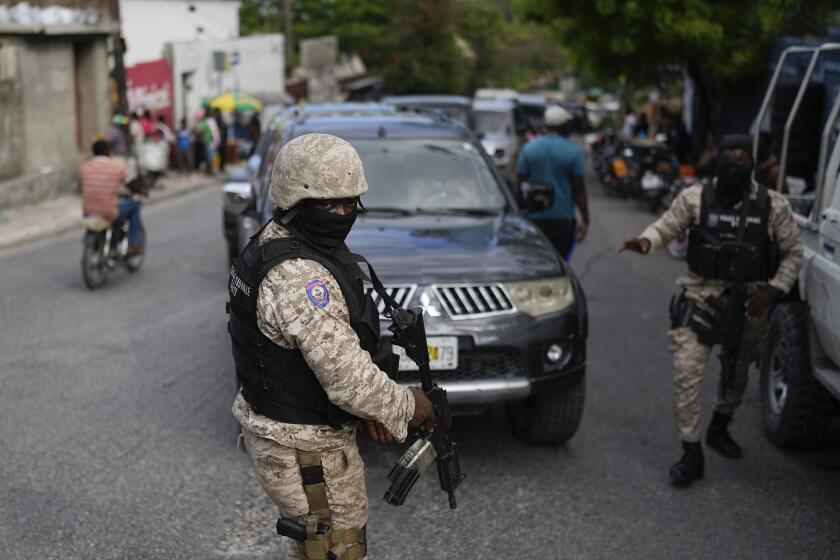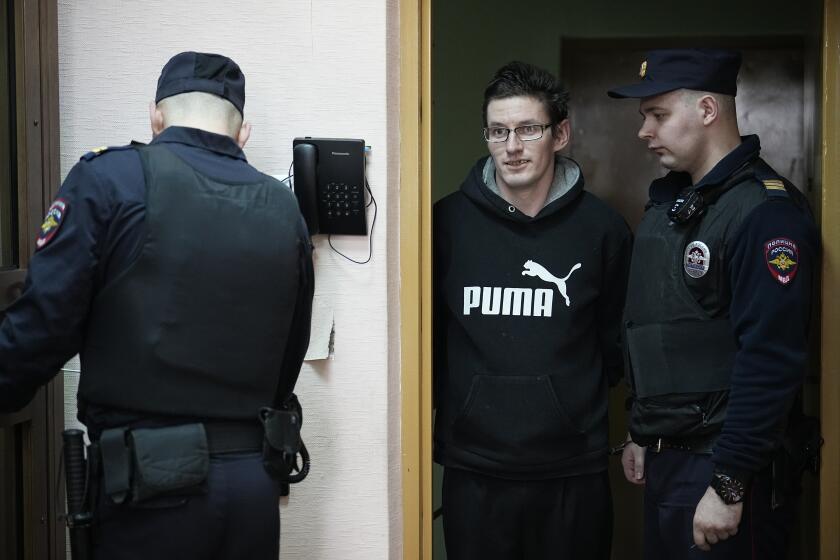A Market in Missiles for Terror
A few weeks ago, a retired American intelligence officer was asked over lunch about the availability on the black market of portable shoulder-launched surface-to-air missiles, which government officials fear terrorists might use against civilian airliners.
The retired officer, who now works for a private weapons firm, called his secretary on a cell phone and asked for the phone number of an East European arms broker. He dialed the broker, who picked up after a few rings.
For the record:
12:00 a.m. Oct. 4, 2003 For The Record
Los Angeles Times Saturday October 04, 2003 Home Edition Main News Part A Page 2 National Desk 1 inches; 54 words Type of Material: Correction
Missiles -- A Section A article on March 6 about the terrorist threat posed by portable surface-to-air missiles, or SAMs, incorrectly identified the Redeye SAM as being Chinese-made. The Redeye is American-made. Both the Redeye and the Red Cherry, a similar but more advanced Chinese model, have turned up on the international black market.
“I have a gentleman seated here with me,” the retired officer began after a short greeting. “Give me the price for the ‘I’ item -- current production or a few years old.”
After a pause of about 20 seconds, the broker came back on the line. A brief conversation ensued, and the two men said goodbye.
The officer then recounted the relevant details to his luncheon companions, including a reporter. The “I” item was code for state-of-the-art Russian-made portable surface-to-air missiles called Iglas (Needles). The arms broker had offered Iglas for a price of $62,000 apiece.
In some ways, the apparent ease of the transaction might be misleading. The retired officer has been involved in the weapons business for nearly three decades. He’s well acquainted with the broker, who knew that the “gentleman” on whose behalf he was negotiating was not a terrorist.
But the conversation was nonetheless reflective of an uncomfortable reality -- namely, that portable surface-to-air missiles, known as SAMs, are available to buyers, legal or otherwise, with the funds to pay for them. Indeed, when asked if his broker would entertain an offer from an unsavory client, the retired officer replied that for the right price, “this guy would sell his mother.”
The availability of portable SAMs on world markets is a growing concern to government officials. In February, the British government deployed about 450 troops at London’s Heathrow Airport after intelligence agencies reported a possible Al Qaeda plan to use portable SAMs against civilian flights.
Three months earlier, suspected Al Qaeda operatives fired two missiles at an Israeli charter flight taking off from Mombasa, Kenya, with 271 people aboard. The missiles, fired just minutes after a suicide car-bomb attack on an Israeli-owned hotel in Mombasa, were 30-year-old Russian Strelas, which are significantly less sophisticated than the Igla. They missed their target.
In May 2002, terrorists fired a Strela at an American plane taking off from the Prince Sultan Air Base in Saudi Arabia. The Saudis charged seven people alleged to have links with the Al Qaeda terrorist network in the failed attack. The cell had held a second Strela in reserve; authorities found it buried in the desert near Riyadh, the capital.
Civilian Planes Hit
Insurgent groups, which cannot legally buy weapons and must procure them on the black market, have scored numerous successes with portable SAMs during the last few decades. A Defense Intelligence Agency study found reports of 29 portable SAM attacks on civilian aircraft between 1978 and 1998, with more than 400 fatalities. Twenty attacks were in Africa, four in Afghanistan, three elsewhere in Asia and two in Central America.
In a 1998 attack, rebels in the Democratic Republic of Congo shot down a Congo Airlines Boeing 727, killing 40 people on board, with what investigators suspected was a Strela. Two and a half months later, a U.N.-chartered flight was shot down over Angola by a portable SAM; 14 people died. In 1994, a portable SAM downed an aircraft carrying the presidents of Rwanda and Burundi, killing both.
“Even before 9/11, we were terrified of the possibility of a SAM attack” on a civilian airliner, said Herbert Calhoun, a senior foreign affairs specialist at the State Department’s Bureau of Political-Military Affairs until he retired in November 2001. “We knew there were lots of them out there, and we knew what they’re capable of doing.”
In the wake of the Mombasa incident, concern in Washington has heightened. Representatives from the Department of Homeland Security, intelligence agencies, the Pentagon’s Northern Command and even NORAD, the joint U.S.-Canadian missile-tracking agency, have been meeting several times a month to map out a series of defensive measures. Airport security directors are meeting with their neighbors to explain how to spot suspicious activities, and the task force is weighing the cost and benefits of various countermeasures.
On the international front, the U.S. is pressing allies to develop a global plan, akin to efforts to disrupt terrorist financing, for preventing terrorists from obtaining portable SAMs.
If terrorists did succeed in bringing down a civilian plane far from a war zone, “you’d have to ground everything,” said Cathal Flynn, who was chief of civil aviation security for the Federal Aviation Administration until late 2000. “It would kill air travel. It would kill it.”
Despite recent attempts to fire SAMs -- and Al Qaeda’s deadly display of its abilities on Sept. 11 -- some analysts say that terrorists are still more likely to opt for simpler methods of inflicting casualties. Even the best portable SAMs can’t reach a plane at cruising altitude, which makes passenger jets highly vulnerable only during takeoff and landing. So potential attackers have to set up close to a runway, where they may be spotted. And, after all the cost and preparation, there’s a reasonable chance they’ll miss, at least with older SAMs, which are prone to malfunction.
“By the time you add up all the things that could go wrong in getting and using SAMs, [terrorists would] rather just buy explosives,” said a former senior CIA operations officer.
Still, of the 750,000 portable SAMs manufactured worldwide during the last four decades, several thousand have been diverted from national arsenals, says Daniel Benjamin, who worked at the National Security Council from 1994 to 1999.
Portable SAMs have turned up on black markets from Latin America to the Middle East to the former Soviet bloc.
Sarkis Soghanalian, an Armenian-born Lebanese arms broker who has a long history of covert weapons deals, including some at the request of the CIA, says Ukraine and Yemen are among many places where portable SAMs can be easily purchased.
“Buyers can get whatever they want,” Soghanalian said in a recent phone call from the Jordanian capital, Amman. “There are many brokers who are hungry for money, and they can arrange those deals.”
In 2000, Italian police burst into a hotel room near Milan and arrested a Ukrainian arms dealer named Leonid Minin. The police say they found in his room -- in addition to four naked prostitutes and 58 grams of cocaine -- a green briefcase stuffed with documents that showed Minin had helped ship 68 tons of portable SAMs, antitank weapons and rocket-propelled grenades in 1999 from Ukraine to Burkina Faso.
The West African nation, which can legally purchase arms, served merely as a brief transit point. From there, documents show, Minin’s private jet carried the weapons to Liberia, which is barred from purchasing arms under a United Nations embargo.
In addition to an assortment of Russian portable SAM models, the French Mistral, the Chinese Red Eye, the British Blowpipe and many others have turned up on the international black market.
$125,000 Price Tag
Prices for some newer models can run as high as $125,000, but older versions cost far less. An international arms merchant provided The Times with a written quote he received in 1996 from Elmet Engineering, a Bulgarian firm. The prices offered by Elmet -- which the broker says are still roughly accurate for covert deals -- were $7,400 apiece for older Russian-made Strelas, plus $3,400 for a launcher to fire the missiles. The price for a newer-model Strela, which features a bigger warhead and a guidance system greatly improved over the earlier model’s, was $22,700 per missile and $9,150 for the launcher.
Elmet is not known to be choosy about its customers. In 1997, U.N. inspectors reported that the company had offered to supply more than $1 million worth of eavesdropping equipment to a Baghdad factory linked to Iraqi intelligence. Recent calls to Elmet seeking comment went unanswered.
One of the most highly sought-after portable SAMs on the black market is the American-made Stinger. Dick Stoltz, an agent for the federal Bureau of Alcohol, Tobacco and Firearms, posed as a Florida-based weapons broker from 1999 to 2001. He said a middleman for Pakistani intelligence agents placed an order with him for hundreds of Stingers at about $50,000 apiece. The middleman claimed that the Pakistanis wanted Stingers for, among others, Osama bin Laden, Stoltz said. No weapons were delivered, and just three months before Sept. 11, the middleman, a U.S. citizen, was arrested and later pleaded guilty to attempting to export Stingers.
The Stinger’s popularity dates to the mid-1980s, when the CIA shipped about 1,000 of the missiles to Afghan rebels fighting a Soviet-backed regime. Soon after their arrival in Afghanistan, the Stingers began leaking out to various parties. Iranian Revolutionary Guards ambushed an Afghan rebel military caravan and made off with several dozen missiles. Pakistani intelligence, which distributed the CIA-supplied arms to the rebels during the war, skimmed a number off the top for its own stockpiles. Pakistan also sold a Stinger to China, which through reverse engineering developed its own version.
Missing Missiles
After the rebels drove the Red Army out of Afghanistan in 1989, hundreds of unused Stingers went missing.
To stem the damage, the CIA began a program to buy back its missing Stingers. By 1993, the agency had allocated $65 million for the program -- about twice the cost of the original 1,000 missiles sent to the rebels -- but it is said to have had only a few dozen takers.
The Taliban is believed to have inherited many of the Stingers when it seized control of Afghanistan three years later. Iraq and North Korea are also believed to have acquired some of the Stingers, according to a study by Alan J. Kuperman, assistant professor of international relations at Johns Hopkins University’s School of Advanced International Studies. Anti-government rebels in Turkey as well as Hezbollah guerrillas operating in Lebanon are also thought to possess the missiles.
Portable SAMs are relatively simple to operate. Manufacturer’s literature for Strelas states that the missiles “can be launched from trenches, from positions on water, swampy areas, from the roofs of buildings, from armored vehicles, as well as from vehicles in a stopped position or moving at a speed of up to twenty kilometers per hour.”
Even the more sophisticated Stinger does not require extensive training: “The missile’s complexity can be accommodated by almost any potential user nation or group,” says a U.S. military fact sheet about the Stinger.
Shoulder-launched SAMs are small enough to fit in the back of a truck and relatively easy to smuggle across borders. The Stinger, for example, is 5 feet long and 5.5 inches wide and weighs just 34.5 pounds fully armed.
Deflecting Attacks
Older-model portable SAMs are of little use against military aircraft, which are equipped with means to defeat them. Afghan rebels fired heat-seeking Strelas at Soviet helicopters, but the pilots would simply fire off intensely hot flares and the missiles would chase the flares instead of the helicopter.
But the older heat-seeking models are considered to be highly effective against civilian airliners, which don’t carry defenses. A 747 -- which has four huge engines -- offers a much bigger heat “signature” than almost all military aircraft.
“Even older SAMs are deadly against civilian planes,” said Angelo Codevilla, a former senior staff member of the Senate Intelligence Committee. “They are big, fat, slow targets.”
Advanced Models
The more advanced portable SAMs, such as American Stingers and Russian Iglas, have longer ranges and use infrared homing systems, which are much more difficult to defeat than heat-seeking missiles.
It would be possible to retrofit commercial planes with countermeasures against SAMs, but that would take a huge amount of time and could easily cost $2 million per plane. Also, some of the technology could present as many problems as solutions. Stored decoy flares, for example, can cause onboard fires, and some experts think jamming equipment might interfere with other necessary transmitters.
Retired Adm. Bobby Ray Inman, a former head of the National Security Agency and deputy CIA director, believes that getting SAMs into the U.S. would be a challenge, but he worries about risks at airports in the Middle East and Africa.
“It’s not clear if the [shooters] in Mombasa were incompetent, or if the missiles were defective or the plane was beyond their range, but it’s clear that the airport there had little security,” he said.
Flynn, the former FAA security official, says that he pushed the Transportation Department during his tenure to come up with a nationwide plan to prevent or respond to an attack but that top officials felt considerably less urgency than he did.
At the time, the intelligence community rated the prospect of a shoulder-fired missile being fired by terrorists in the U.S. as “low to medium.” However, twice during the Clinton years, intelligence agencies scrambled when reports suggested that Al Qaeda planned to target overseas flights with portable SAMs. At one point, the government even considered suspending flights by U.S. carriers to two specific locations outside the Americas, says Flynn. In the end, that was deemed unnecessary.
“People went into overdrive to thwart suspects and secure targets,” said Benjamin, the former NSC staffer. “We don’t know if the measures worked or not because [the attacks] never happened.”
More recently, U.S. forces operating in Afghanistan have recovered older-model Strela and Blowpipe SAMs as well as more sophisticated Russian-made models. Al Qaeda training films left behind in Afghanistan provided step-by-step instructions on how to use Strelas.
Franklin C. “Chuck” Spinney, a Pentagon analyst who specializes in tactical aviation, said the portable SAMs on the market and terrorists’ recent attempts to obtain and use them are a worrisome combination.
“Sooner or later,” he said, “they’re probably going to hit a plane.”
More to Read
Start your day right
Sign up for Essential California for news, features and recommendations from the L.A. Times and beyond in your inbox six days a week.
You may occasionally receive promotional content from the Los Angeles Times.






